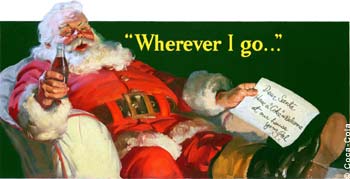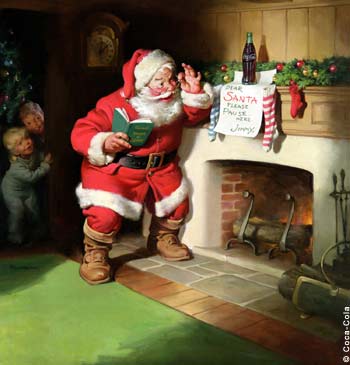

Christmas is an old custom that originated long before Jesus Christ was born. The Church reinvented the originally pagan fest and added some features. Today nobody really cares about the old tradition, the origins and the old customs. But everybody is happy: the parents, the children, the Church, and the industry. Giving is always a good thing and Christmas is the biggest shopping event of the year. A multi-billion dollar industry.
December 25th – birth of Jesus? Hardly! In fact, on December 25th the birth of the child is celebrated, but when digging into the story it seems very unlikely that this happened during winter month December. Doing research brings not really the solution. Too many theories about the actual birth date exist. The bible itself makes no statement either – otherwise it wouldn’t be difficult to pin-point the date, of course!
Anyhow, is there any hint that those shepherds, kings, sheep, and whoever else, stood around the cradle while it was cold outside? Even if we consider the degree of latitude it remains unlikely. It was not until the 4th century A.D. that the 25th of December was selected as the official date of birth of Jesus. Saying ‘Officially’ means that a prominent member of the church, most resources speak about a pope, constituted this day. Some say it was Julius I., but the year is not clear. May be 320 A.D., but he wasn’t even pope at this time, so how could he make such a decision?
However, in the end nobody seems to care about if it was the 25th of December or not. At least Jesus was born at all and if ‘everyone’ considers the 25th as the day it is just o.k. for most people.
Christmas
Christmas, respectively the celebration around that date, were known long before. Romans celebrated their pagan fest Saturnalia to honor and please the God of the Sun. Giving and decorating was common. This celebration happened on the occasion of the Winter Solstice. Also Greek and Persians had similiar celebrations even earlier. The church considered such pagan revelry as disturbing and saw as only solution to convert and adapt the celebration in a manner that it was in accordance with their beliefs. So they established at the same time the celebration of “Christes Maesse” (Latin) and melted it with the pagan origin. Christmas was born and under control. It was from now on a christian fest.
The word ‘Christmas’ is derived from Christes Maesse. The abbreviation ‘X-mas’ was invented during the 16th century. The ‘X’ comes from the Greek word for Christ: Xristos.
Christmas came with the immigrants to America, but not necessarily with the Pilgrims. Since the couldn’t find the exact birth date of Jesus in the book of the books, they were unsure about the 25th. But they definitely knew that this day couldn’t be a day of big celebrations, of revelry. So it came that as long as the Pilgrims had in some way enough influence the Christmas celebration was prohibited in the New England area.
Nicolaus and Santa Claus.
Historically, the Santa Claus legend dates back as far as 300 A.D. and carries with it fascinating stories of the selfless acts of the first Bishop of Myra in Asia Minor (modern day Turkey), first known for his kindness to children and his help to the needy. This man was Bishop Nicholas, later Saint Nicholas. He died end of the first half of the 4.th century on December 6th. In the German speaking countries and the Netherlands it is a tradition and custom that ‘Nikolaus’ visits the homes of the people and brings sweets and little presents for the children. The French had once in the 13th century a tradition to celebrate the ‘Feast of St. Nicholas’ by bringing food to the poor. Anyhow, Saint Nicholas became associated with Christmas.
This custom never made it to America and Santa Claus and Nicholas melted to one figure – but nobody really knew how his appearance was. Wildest illustrations were seen, sometimes he appeared as a gnome, the as an elfe or a fur-covered giant. Other countries arranged for the accessories of Santa. The reindeer and sleigh originated in Norway or Sweden and the pipe and chimney in Holland.
Coca-Cola® In 1931 the Coca-Cola Company came for help. It was Haddon Sundblom, an well-known illustrator, who was commissioned by The Coca-Cola Company in 1931 to develop an advertising image for the holidays. Inspired by Clement Clark Moore’s 1822 poem “A Visit from St. Nicholas,” which described the toy maker as “chubby and plump, a right jolly old elf,” Sundblom created the modern day image of Santa Claus. Through this image and the power of the mass media, nearly every household in America became familiar with Sundblom’s Santa.
“The value of Haddon Sundblom’s Santa goes beyond the worth of the paintings themselves,” stated Philip F. Mooney, manager, Archives Department of The Coca-Cola Company. “He represents everything we cherish about the holidays: family, enjoyment and tradition. The Sundblom Santa is an enduring symbol of the spirit of the holidays and we are proud to ignite this season with an artistic trip down memory lane.”
The Santa Claus that is an established part of the holiday tradition was an invention of Victorian America. The 19th century mass media gave this Santa credibility by fashioning him as a part of an ancient folk tradition—a mythical hero unchanged by consumer culture.
Yet Santa has always been commercial. Santa’s earliest likenesses were fashioned by mass media artists. Initially, these artists created many different “Santas,” ranging from an authoritarian figure to the kind and benevolent one known today. Famous illustrators including Thomas Nast, J. C. Leyendecker, and Norman Rockwell standardized a more consistent image of Santa in the popular press.
These precedents influenced the Santa that Haddon Sundblom created for Coca-Cola in 1931. Coca-Cola hired Sundblom to paint a figure that would encourage Americans to drink Coke in the winter months. (Until 1931, Coke was considered a summer beverage.) Sundblom created at least one Santa annually for Coca-Cola through 1964.
Conceived during the Great Depression, Sundblom’s merry, portly Santa changed very little over the years. Reproduced by the millions, Sundblom’s Santa boosted winter sales and became a holiday archetype that endures in television, films, and department stores today.
Happy X-mas!

